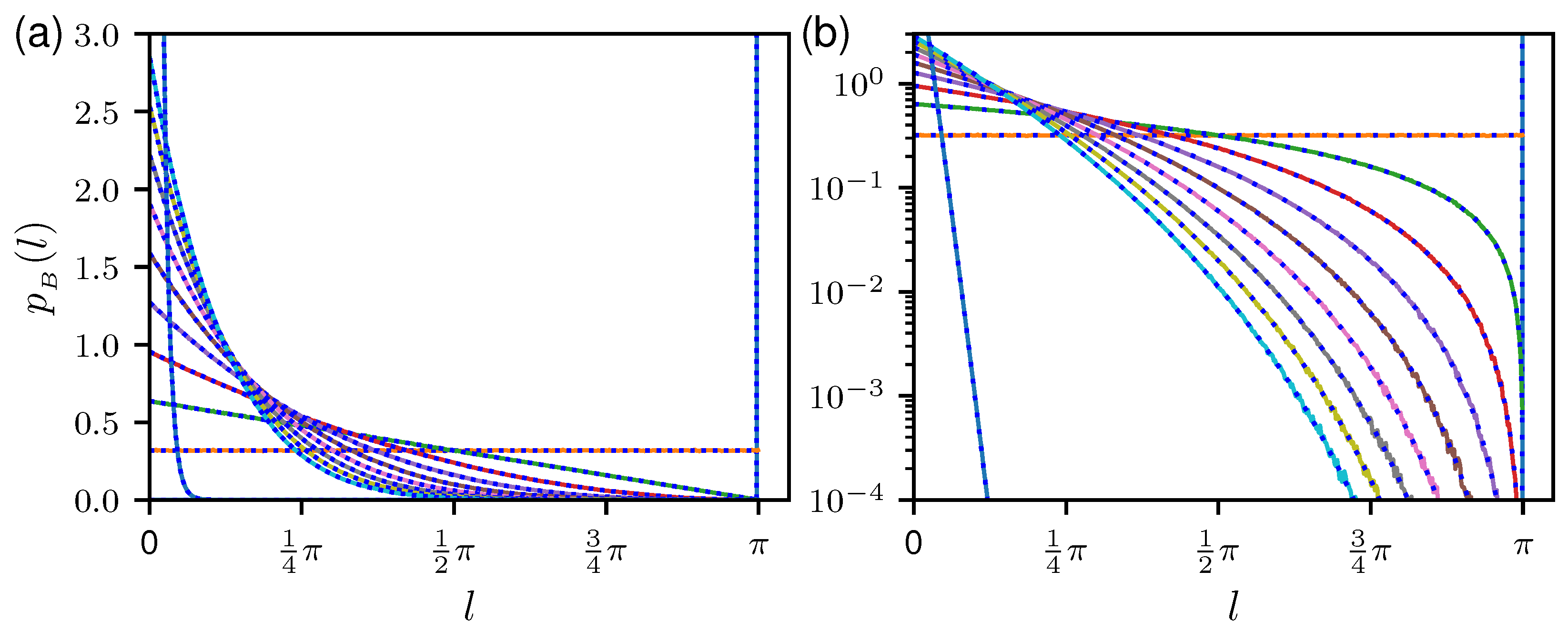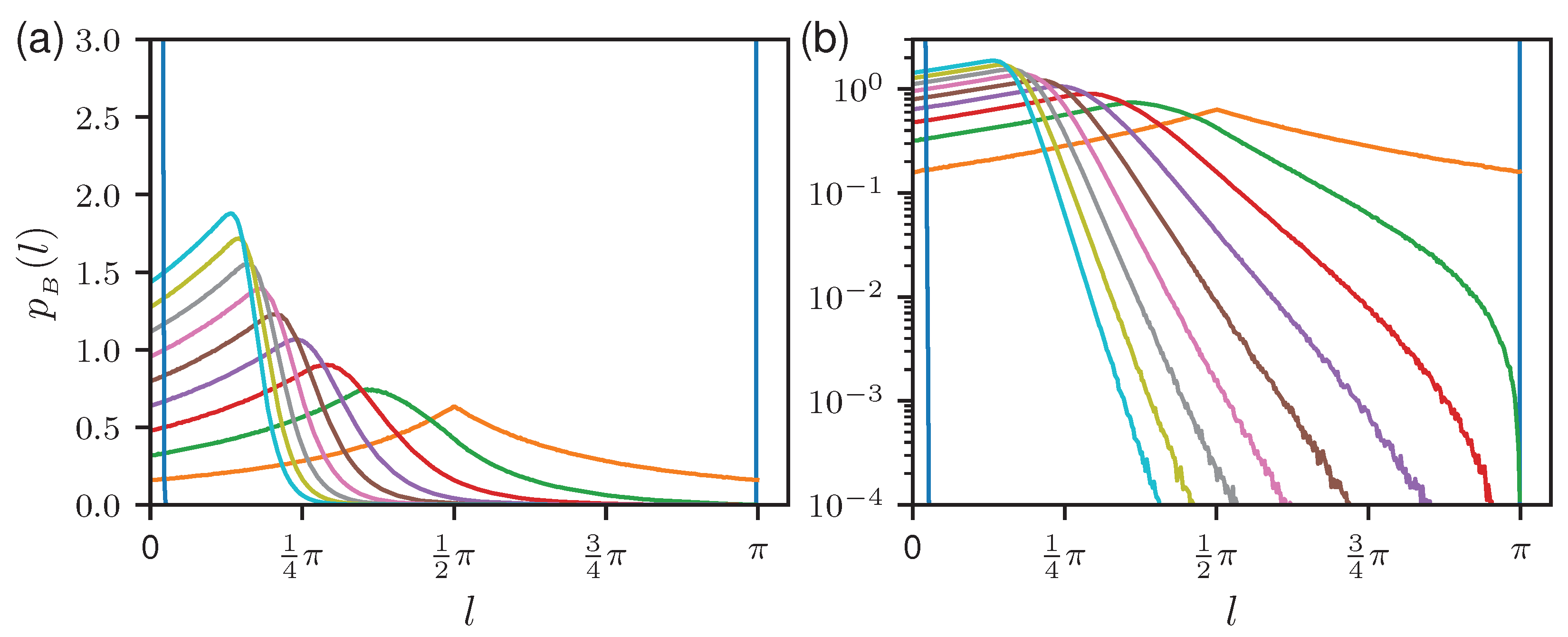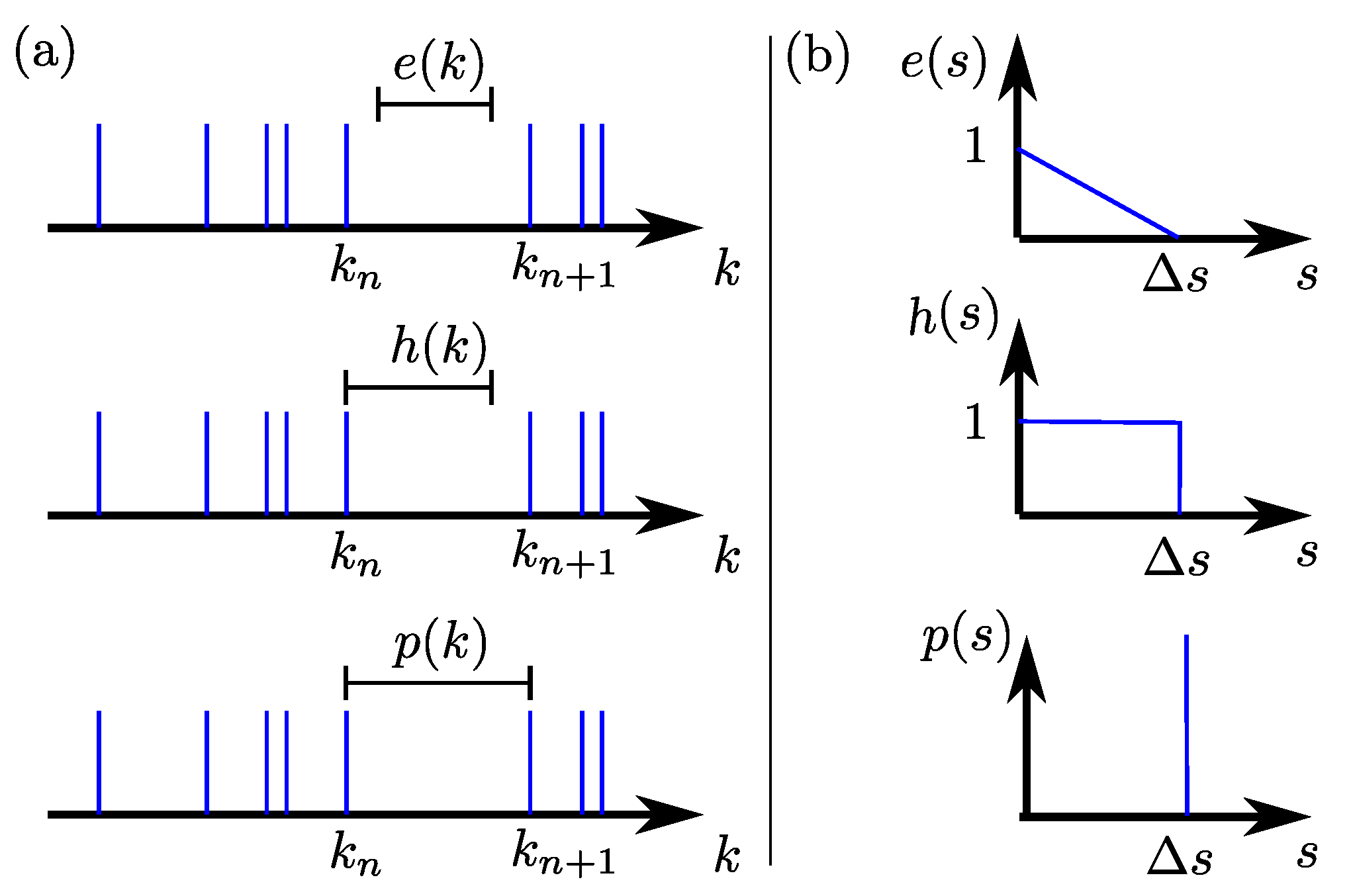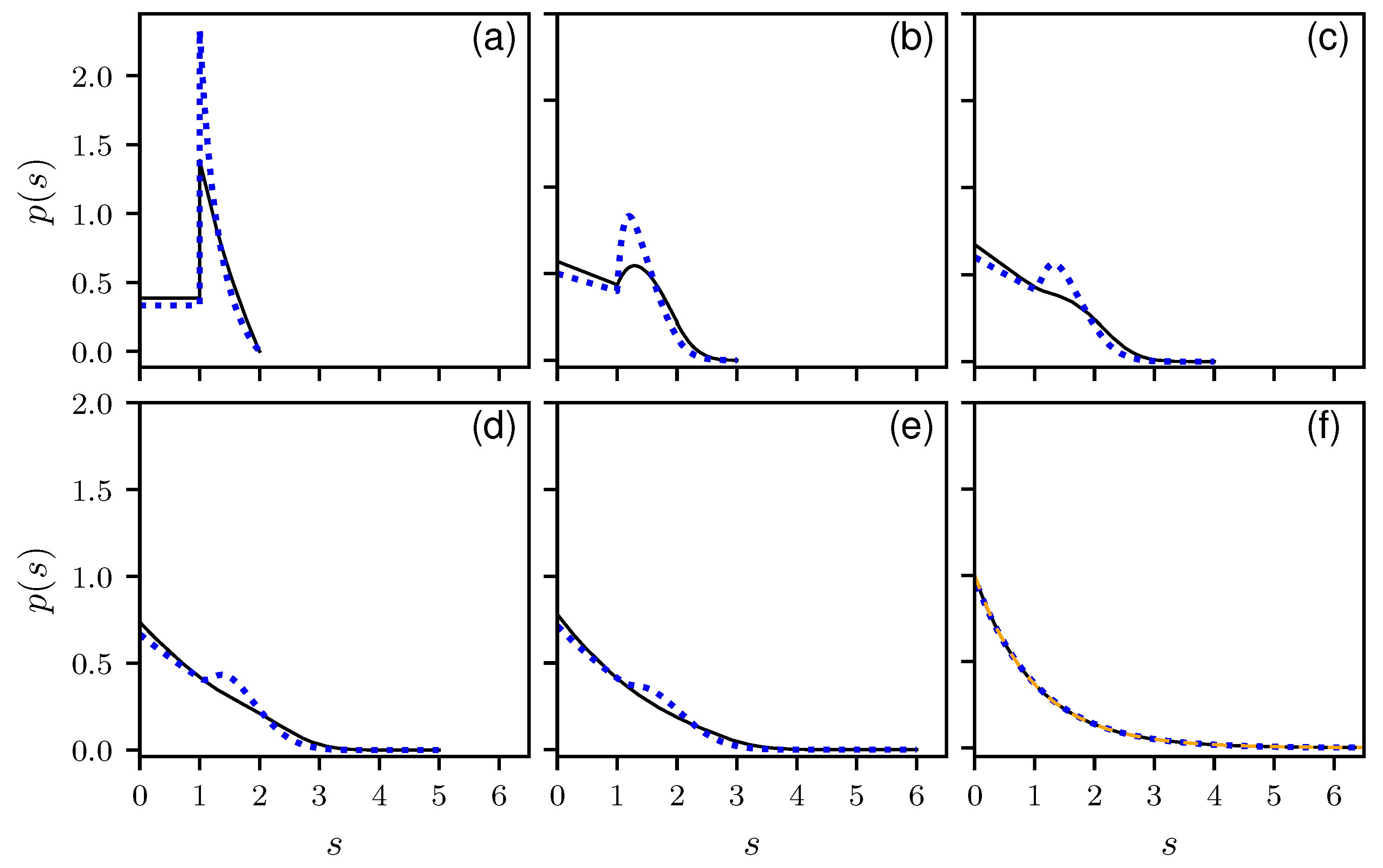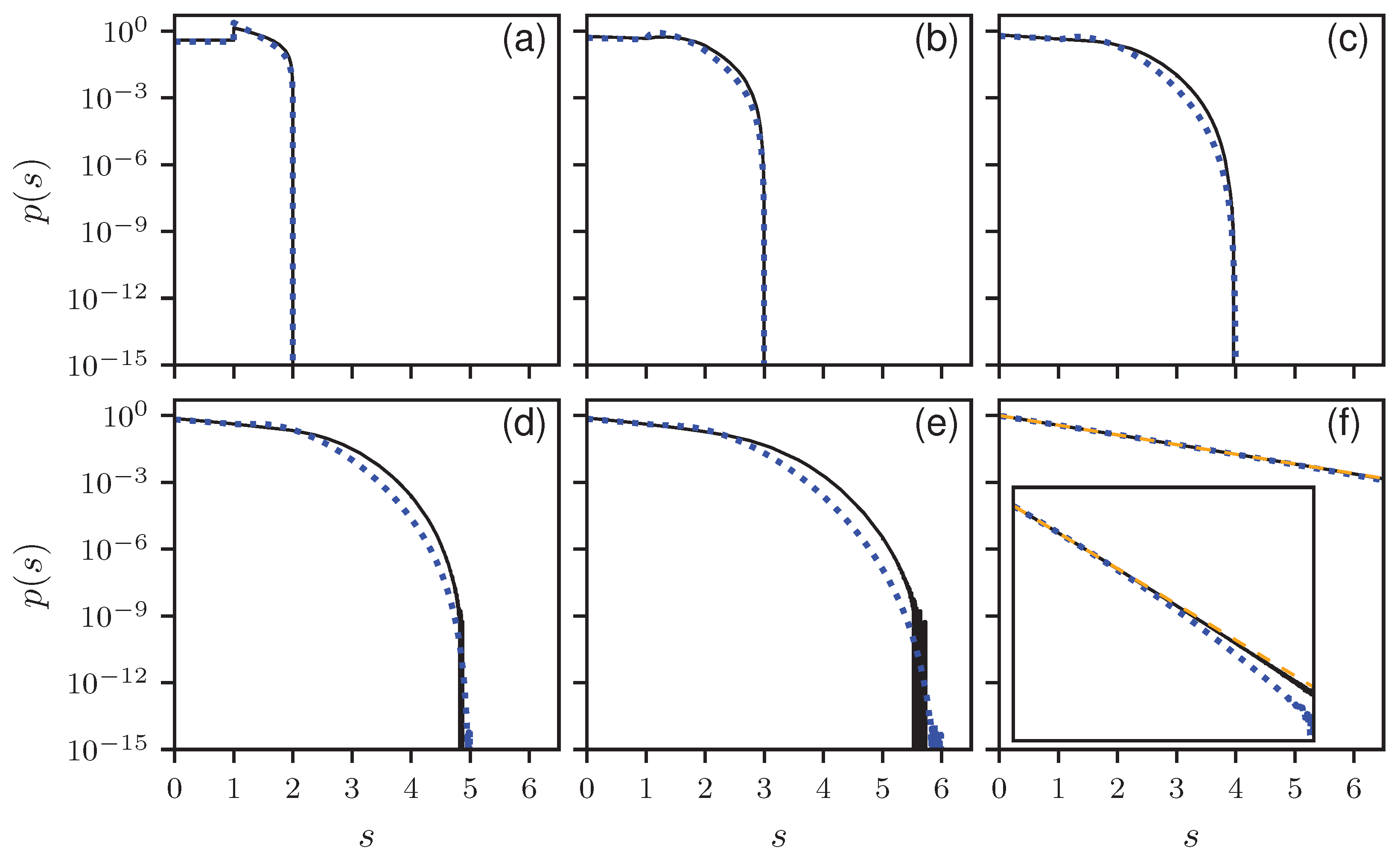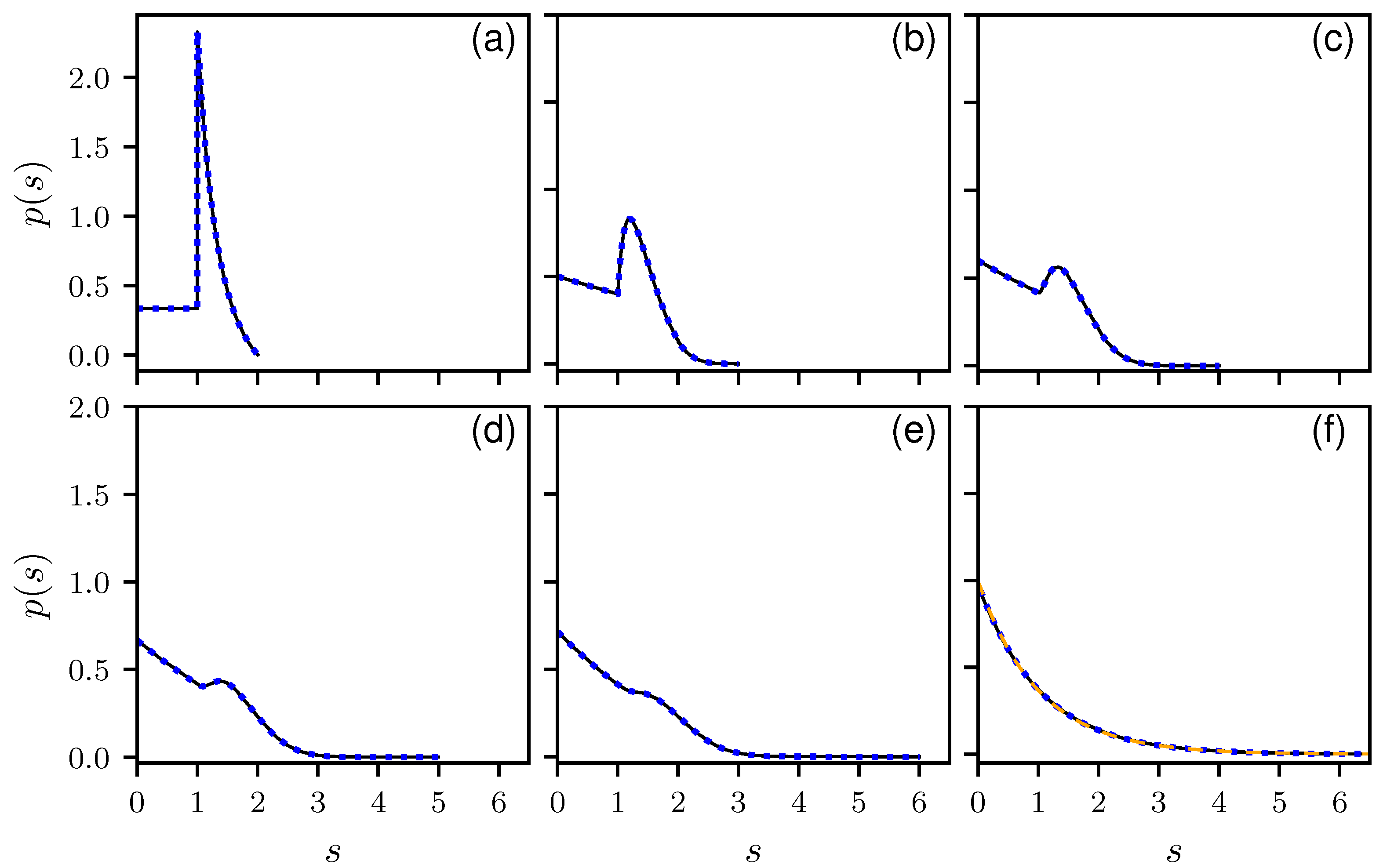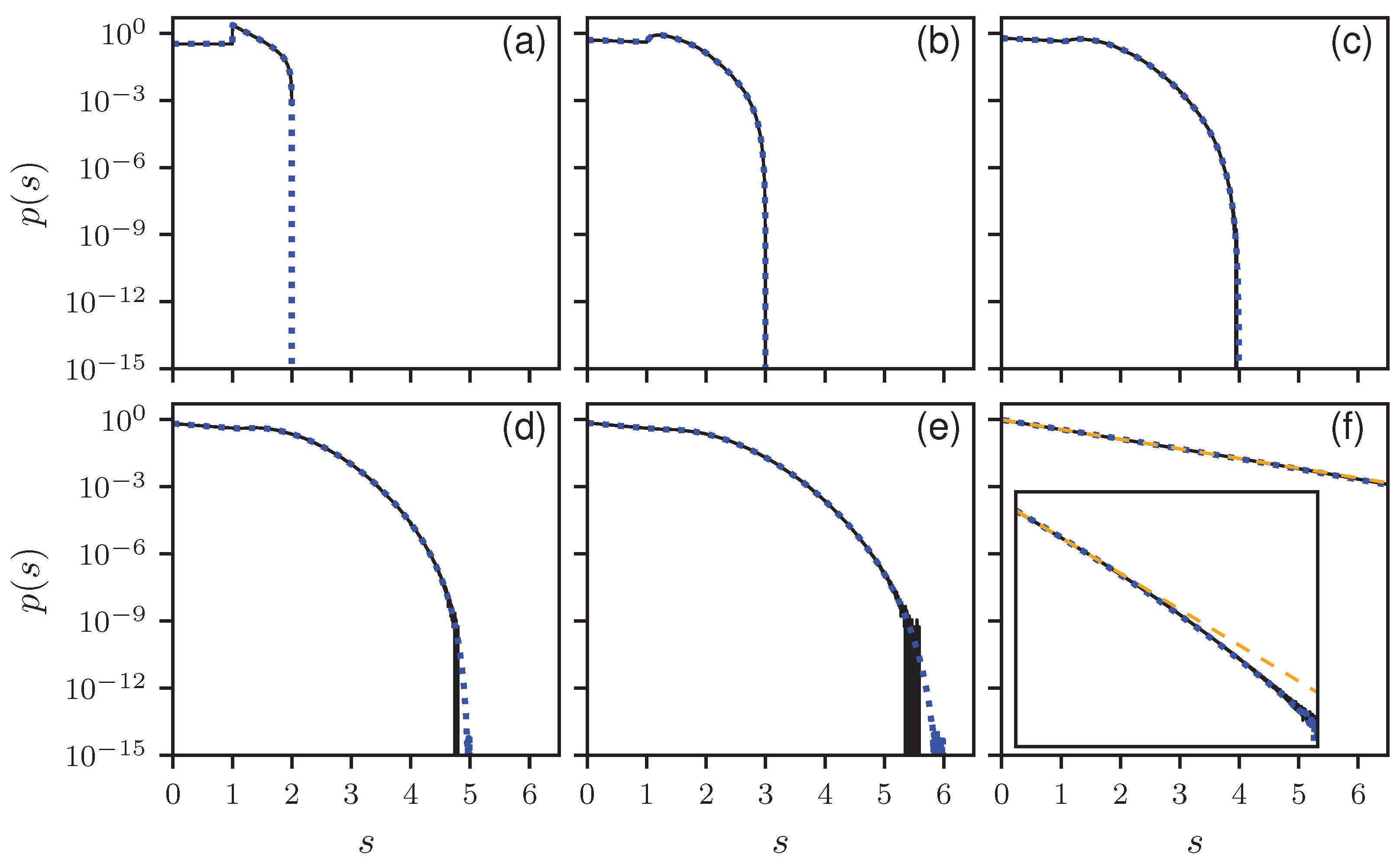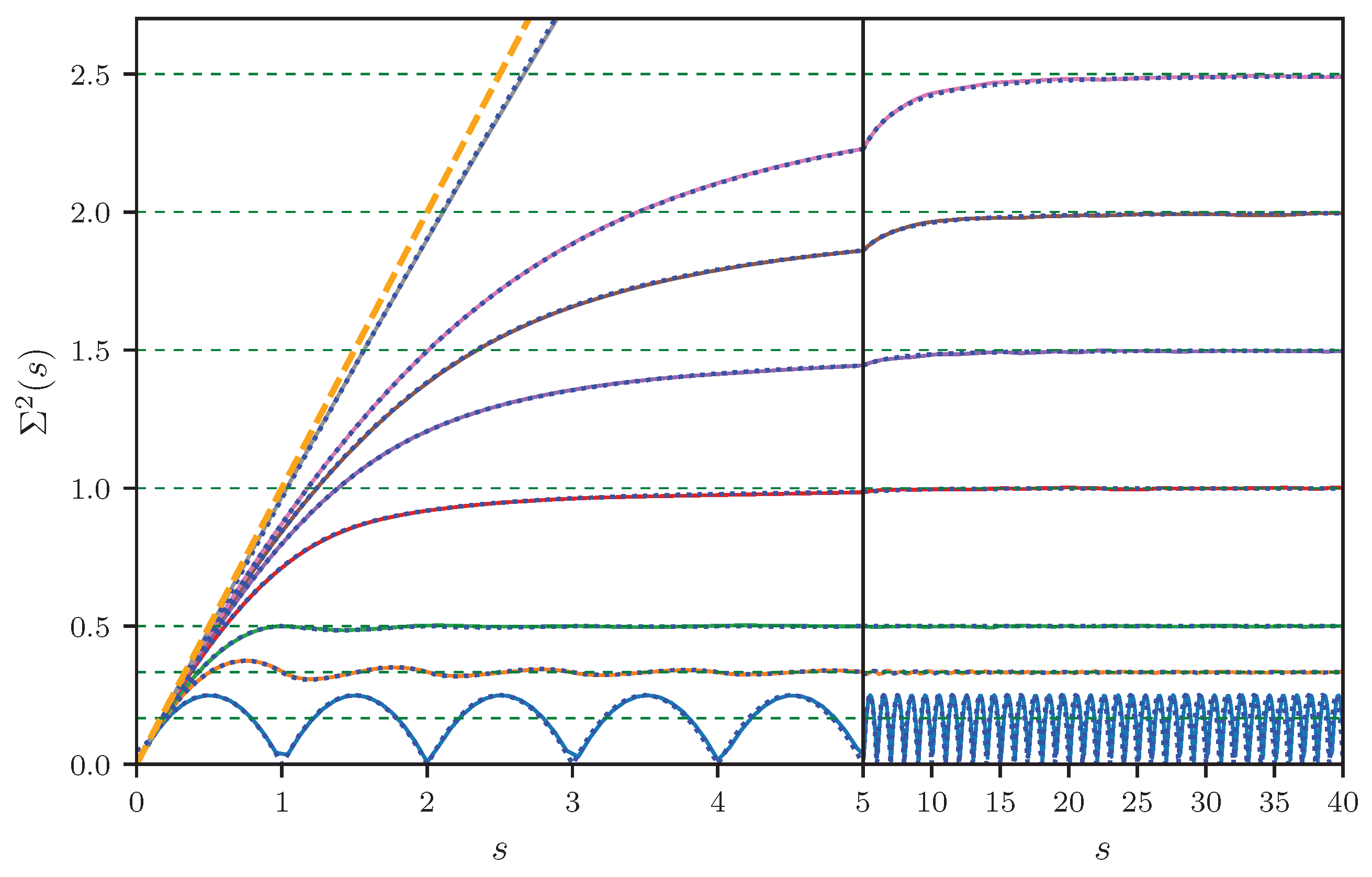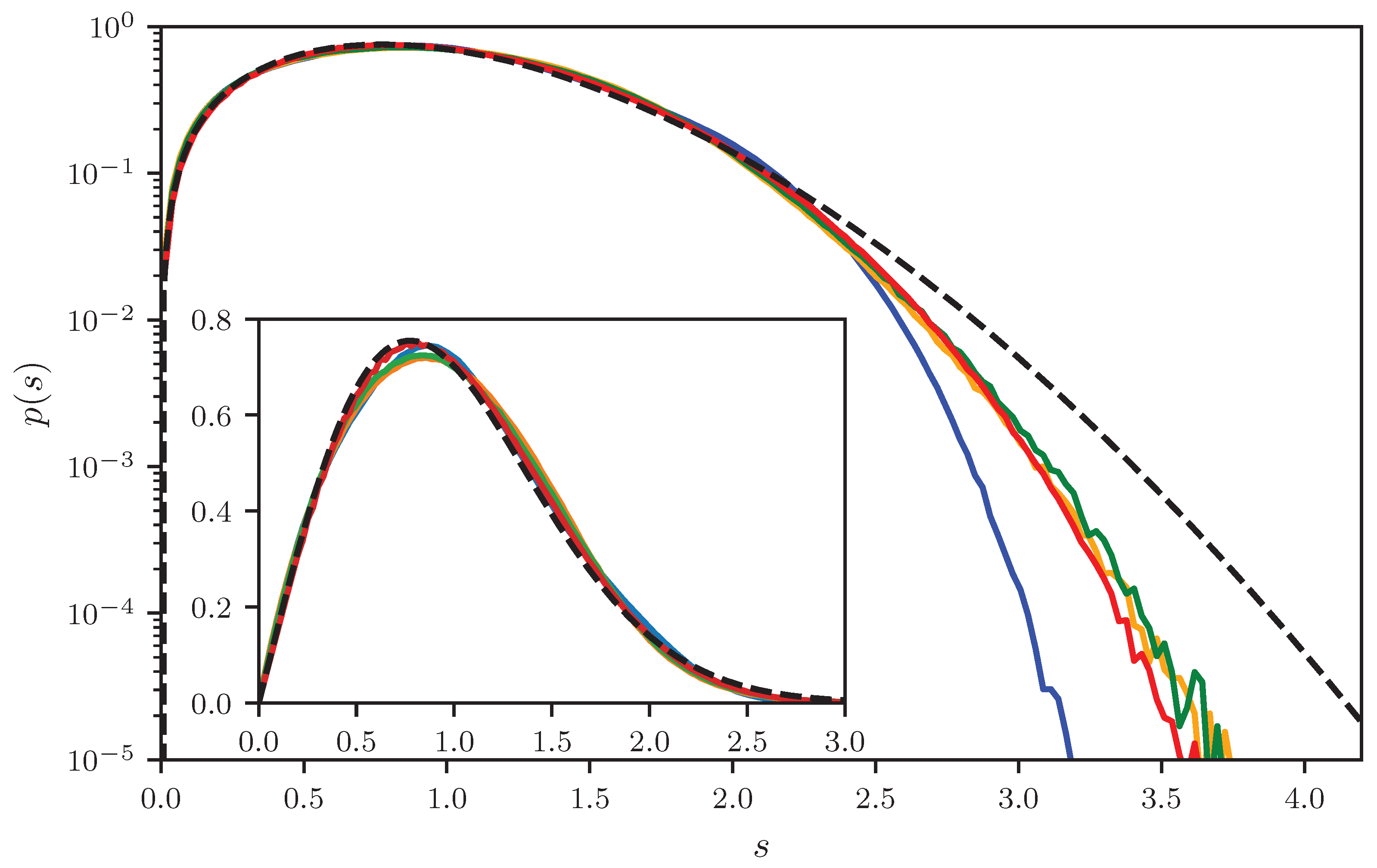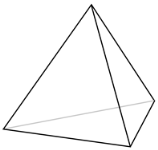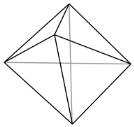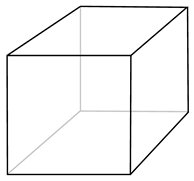1. Motivation
Quantum graphs are composed of bonds which are connected with each other at vertices. Along the bonds wave propagation is governed by the Schrödinger equation without potential and boundary conditions depending on the details of the coupling at the vertices. Quantum graphs were first introduced by Pauling [
1] in the context of free electron models of organic molecules. Later, they were studied intensely in physics [
2] and mathematics [
3], and experimentally implemented in correspondingly-shaped microwave networks [
4]. They are conceptually simple, but still complex, and there is a straightforward symbolic alphabet to classify the periodic orbits. Casati and coworkers [
5] suggested that the universal features of the spectra of chaotic systems might be described by random matrix theory (RMT), which later was expressed by Bohigas, Giannoni, and Schmit [
6] in the form of a conjecture. Using supersymmetry techniques, Gnutzmann and Altland [
7] proved the conjecture for the two-point correlation function for fully connected graphs with incommensurate bond lengths. Their result was generalized to all correlation functions by Pluhař and Weidenmüller [
8]. Just as for billiard systems [
9], there is a one-to-one correspondence between a quantum graph and the corresponding microwave networks, which has been used, in particular, by Sirko and coworkers in numerous experiments to study spectral and scattering properties of microwave graphs (see e.g., Ref. [
4]).
In a recent microwave experiment in tetrahedral graphs [
10], however, we noticed that one important aspect is missing in the above scenario. It is hidden in the structure of the equation system determining the graph spectrum. Using energy and current conservation (the Kirchhoff rules in experimental networks), one arrives at a secular equation [
2]
where the sum runs over all vertices
V, and
is the potential at vertex
m. In the experiment, the bonds are connected by ordinary T junctions corresponding to Neumann boundary conditions. For this situation, the elements of the secular matrix
h are given by
where the
are the lengths of the bonds connecting vertices
n and
m, and
k is the wave number. For the homogeneous equation system (
1) to have non-trivial solutions, the determinant of
has to vanish,
The roots of the equation generate the spectrum of the graph. It will be called “Neumann” spectrum in the following since the T junctions at all vertices obey Neumann boundary conditions. On the other hand, becomes singular, whenever is an integer multiple of . This situation corresponds to a totally disassembled graph with a spectrum being the sum of the spectra of all individual bonds with Dirichlet boundary conditions at both ends, thus the vertices have no influence any longer. This “Dirichlet” spectrum hence appears via the poles of , whereas the Neumann spectrum is given by the zeros of . In the following, all lengths will be assumed to be incommensurable to avoid degeneracies of the Dirichlet spectrum.
This “spectral duality”, as we termed it in our previous publication [
10], has important consequences for the spectral statistics. The cause is the interlacing theorem (see, e.g., Chapter 3.11 of Ref. [
3]):
If the boundary conditions at one vertex of a graph are changed from Neumann to Dirichlet, or somewhere in between, the eigenvalues of the original and the new graph appear strictly alternating.To move from the Neumann to the Dirichlet spectrum for a complete graph, the boundary conditions have to be changed one after the other at all vertices, not just at one of them. Now, there is no longer a strict alternation in the sequence of the respective eigenvalues, but still a strong correlation remains—the maximum number of Neumann eigenvalues confined between two successive Dirichlet ones is given by the number of vertices V, and vice versa.
The mean density of states for a graph of a total length of
is given by
For a graph with
B bonds and a given total length, the maximum level spacing is found for the limiting case where all bonds are equal. For this case, the Dirichlet spectrum is
B-fold degenerate, and the maximum distance between neighboring eigenvalues, in units of the mean level spacing, is just
. Due to the interlacing theorem, the same must be true for the Neumann resonances. There is hence a cut-off in the level spacing distribution
at
, at the latest, both for the Dirichlet and the Neumann spectrum. Consequences of spectral interlacing for the number variance have been discussed already in our previous paper [
10].
Thus, there are clear deviations from the RMT expectation for small graphs. This is not in contradiction with the proofs mentioned in the beginning that the spectra of graphs with irrational length ratio do exhibit RMT behavior, since these proofs work in the limit of infinitely large graphs only. From the practical point of view this is of little help since numerical, as well as experimental, studies are necessarily restricted to comparatively small graphs.
Therefore, an understanding of the impact of Dirichlet–Neumann interlacing is mandatory for the correct interpretation of the spectral statistics in small graphs. Since, in the moment, a good idea to approach Neumann spectral statistics is still missing, we start with a more modest task—the interpretation of Dirichlet spectral statistics. Analytic results are given for level spacing distribution and number variance for a random superposition of lattice fence spectra and compared with numerical results. For the Neumann spectra, we restrict ourselves to an illustration of the fingerprints of spectral interlacing in level spacing distribution and number variance, but have to leave the theoretical interpretation to future papers. We do not discuss experimental results from microwave graphs in the present paper. This remark may be necessary since probably this is exactly what readers do expect from our group.
2. Dirichlet Graphs
For Dirichlet graphs, there are Dirichlet boundary conditions at each end of all bonds, thus the bonds are not coupled at the vertices and the spectrum corresponds to a superposition of
B separated bonds. Here, we present analytical and numerical results of the spectral statistics for ensemble-averaged Dirichlet graphs. Following the usual practice, the mean density of states
was kept constant and normalized to one, meaning a total length of
for all graphs entering the average. For the numerics, the lengths had been created by generating
random numbers
between 0 and
, and by taking the appearing
B segments as lengths
. The procedure yields
for the joint length probability. The
are hence uniformly distributed on the interval 0 to
with the constraint
. Integrating out all
but one obtains the distribution
for the remaining
l, being constant only for
. The derivation and a plot of the length distributions can be found in
Appendix A.
Alternatively, one could think of taking
B lengths
from an interval between 0 and 1, and afterward, normalizing each length via
to a mean density of one, i.e.,
. The resulting joint length probability is non-uniform, in contrast to the one above. For the sake of conciseness, we shall refer in the following to the two respective ensembles as the uniform and the non-uniform one. The non-uniform approach would be more in the spirit of the usual unfolding technique used in quantum chaos to make spectra taken from different systems comparable. For the non-uniform ensemble again, numerical length distributions are presented in
Appendix A. Since it would be hard to obtain analytical results for the non-uniform ensemble, all analytics and numerics, if not explicitly stated differently, are for the uniform one.
In the next two subsections, theoretical expressions for nearest neighbor spacing distribution and number variance are given and compared with numerical data.
2.1. Nearest Neighbor Spacing Distribution for Dirichlet Graphs
To calculate the distribution of nearest neighbors spacings
for the Dirichlet spectrum of a graph, we apply a strategy that had been used already by Berry and Robnik [
11] to calculate
for an uncorrelated superposition of two spectra, one associated with the chaotic part, the other with the regular part of a mixed phase-space system. A key element in the calculation is the gap probability
describing the probability for a spectral range of length
s to be empty of eigenvalues. The gap probability is related to the level spacing distribution via
where a mean level spacing of one has been assumed. Expression (
6) is well-known to those working in the field, but for readers not familiar with the subject, a didactic derivation is given in
Appendix B. For a picket fence spectrum with a mean level spacing of
, the gap probability is given by
is, in contrast to
, multiplicative for superimposed uncorrelated spectra,
whence follows for the Dirichlet spectrum of a graph with
B bonds of lengths
,
From Equation (
9) for
, the Dirichlet level spacing distribution can now be obtained by taking the second derivative, see Equation (
6). The Dirichlet level spacing distribution has already been calculated by Barra and Gaspard [
12], who did not follow, however, the approach of Berry and Robnik [
11]. Their derivation therefore is much less concise and considerably longer then the present one, see the appendix of [
12].
Expression (
9) has to be averaged over all different realizations of
with the constraint that the total length
is constant
with the substitution
, the constraint becomes
Thus,
s is the wave number in units of the mean level spacing
. In the following we shall use the letter
s exclusively for spectra with a mean level spacing of
. Now the average can written as
where
is given by
The factorial in Equation (
12) reflects the number of possible
l sequences to do the average. Equation (
13) can be used to calculate
iteratively. For
, e.g., one obtains
where the limits of integration in the different
s windows take care of the cut-off of
. With help of Equations (
12) and (
6), we now obtain for the level spacing distribution
In this way, the may be obtained iteratively, resulting in formulas with a complexity increasing step by step.
A more direct approach takes advantage of the fact that the integral in Equation (
13) is nothing but a convolution. In such a situation, Laplace transform techniques are the method of choice. Applying a Laplace transform to Equation (
13), the convolution theorem yields
where
and
are the Laplace transforms of
, and
, respectively. Iterating Equation (
16), one gets
whence
is obtained via an inverse Laplace transform
The inverse Laplace transform can be done with the result
where
denotes the largest integer
and
To verify our results, we compare the analytical results with numerical simulations. In
Figure 1, the histograms for
to 6 and 100 are shown together with the corresponding theoretical predictions in a linear, and in
Figure 2 in a logarithmic scale. All distributions show the expected cut-off at
. There is a perfect agreement between numerics and theory. Note the discontinuity for
at
, which for larger
B is smoothed out and vanishes for
, where an an exponential decay is expected, corresponding to a Poisson distribution. This can be seen in
Figure 1f and
Figure 2f, showing the results for
. There are still deviations from the exponential behavior as can be seen in the inset of
Figure 2f, showing the same results over a larger
s range. Still the analytic solution matches better. In
Appendix D, numerical findings are presented for the non-uniform ensemble.
2.2. Number Variance for Dirichlet Graphs
The number variance, defined as
where
n is the number of eigenvalues in an interval of length
s, yields for the lattice fence spectrum of a single bond of length
lIt is convenient to express
in terms of its Fourier transform,
For
B bonds with independent bond lengths
, the spectrum is just the superposition of the
B spectra with bond lengths
. The number variation
is additive for uncorrelated spectra leading to
for the ensemble averaged number variance, where
, and
means the average over all
with the constraint
, i.e.,
with
and
given by Equation (
5).
In
Figure 3, the ensemble averaged number variance for Dirichlet graphs are shown for a number of different bonds. For a single bond (
), there is just one lattice fence spectrum with a spacing of one. Hence, one observes a periodic modulation with an average value of
, as described by Equation (
25). With increasing
B, these oscillations are damped out more and more, until
eventually approaches the linear increase expected for a Poissonian ensemble. A good agreement between the simulations and the analytical predictions given by Equation (
27) is found.
